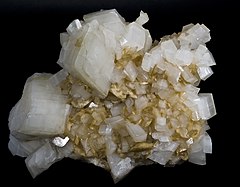Dolomite
| Dolomite | |
|---|---|

Dolomite (white) with magnesite (yellowish) from Spain
|
|
| General | |
| Category | Carbonate minerals |
|
Formula (repeating unit) |
CaMg(CO3)2 |
| Strunz classification | 5.AB.10 |
| Crystal system | Trigonal |
| Crystal class | Rhombohedral (3) H-M symbol: (3) |
| Space group | R3 |
| Unit cell | a = 4.8012(1), c = 16.002 [Å]; Z = 3 |
| Identification | |
| Color | White, gray to pink |
| Crystal habit | Tabular crystals, often with curved faces, also columnar, stalactitic, granular, massive. |
| Twinning | Common as simple contact twins |
| Cleavage | Perfect on {1011}, rhombohedral cleavage |
| Fracture | Conchoidal |
| Tenacity | Brittle |
| Mohs scale hardness | 3.5 to 4 |
| Luster | Vitreous to pearly |
| Streak | White |
| Specific gravity | 2.84–2.86 |
| Optical properties | Uniaxial (-) |
| Refractive index | nω = 1.679–1.681 nε = 1.500 |
| Birefringence | δ = 0.179–0.181 |
| Solubility | Poorly soluble in dilute HCl |
| Other characteristics | May fluoresce white to pink under UV; triboluminescent. Ksp values vary between 1x10−19 to 1x10−17 |
| References | |
Dolomite (pronunciation: /ˈdɒləmaɪt/) is an anhydrous carbonate mineral composed of calcium magnesium carbonate, ideally CaMg(CO3)2. The term is also used for a sedimentary carbonate rock composed mostly of the mineral dolomite. An alternative name sometimes used for the dolomitic rock type is dolostone.
Most probably the mineral dolomite was first described by Carl Linnaeus in 1768. In 1791, it was described as a rock by the French naturalist and geologist Déodat Gratet de Dolomieu (1750–1801), first in buildings of the old city of Rome, and later as samples collected in the mountains now known as the Dolomite Alps of northern Italy. Nicolas-Théodore de Saussure first named the mineral (after Dolomieu) in March 1792.
The mineral dolomite crystallizes in the trigonal-rhombohedral system. It forms white, tan, gray, or pink crystals. Dolomite is a double carbonate, having an alternating structural arrangement of calcium and magnesium ions. It does not rapidly dissolve or effervesce (fizz) in dilute hydrochloric acid as calcite does. Crystal twinning is common.
...
Wikipedia
